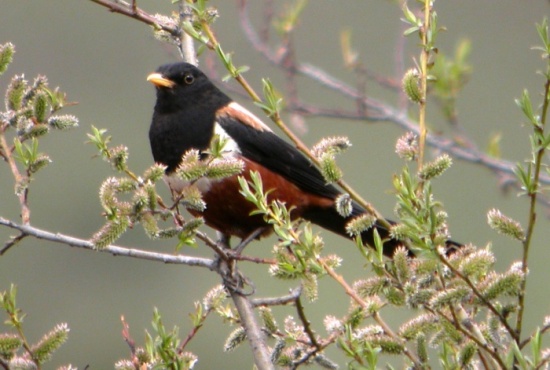Alternative name: White-backed Thrush; Przevalski's Thrush
- Turdus kessleri
Identification
With 28cm a large thrush.
Male:
- Black hood
- Black wings and tail
- Pale buff mantle and lower breast
- Dark chestnut scapulars, rump and belly
Female:
- Same pattern but duller
- Dark brown hood and grey mantle
- Grey breast
Juvenile:
- Similar to female
- Heavy white spots on scapulars and mantle
- Pale streaks on head
Similar species
The female looks similar to the local race of Eurasian Blackbird (Tibetian Blackbird). Chestnut Thrush has a similar pattern but the hood is not as dark and the mantle is dark chestnut.
Distribution
Mainly found in the east and northeast of the Tibetian Plateau in China (Qinghai, Gansu, Yunnan, Xizang). Vagrant in winter to the Himalayas of Nepal and Bhutan.
Taxonomy
Monotypic.
Habitat
Dwarf bushes (eg rhododendron or juniper) and rocky scrub above the tree-line. Usually found at 3600 - 4500m, descending to 2000m in winter.
Behaviour
Feeds on insects, worms and berries (autumn), mostly foraging on the ground.
Often seen in flocks or with other thrushes.
Breeding season from May to August. A sociable nester, while females are incubating the males are together in feeding flocks. The nest is a cup, made of gras stems, feathers and hair, placed in a bush or under a rock over streambed. 3 - 4 eggs are laid.
A semi-nomadic species with altitudinal movements in winter, moving down in extreme cold weather.
References
- Del Hoyo, J, A Elliot, and D Christie, eds. 2005. Handbook of the Birds of the World. Volume 10: Cuckoo-Shrikes to Thrushes. Barcelona: Lynx Edicions. ISBN 978-8487334726
- Rasmussen, PC and JC Anderton. 2005. Birds of South Asia: The Ripley Guide. Barcelona: Lynx Edicions. ISBN 978-8487334672




